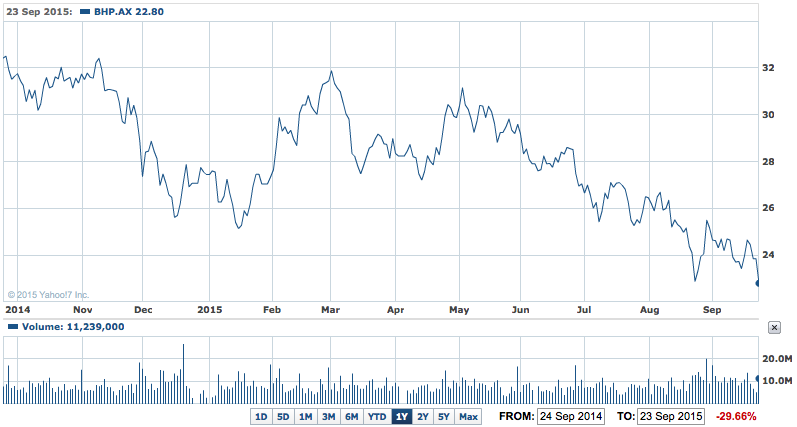BHP Billiton (BHP) yesterday sprung a major surprise on its Australian shareholders by asking them to effectively sacrifice some of the company’s franking credits to allow it to meet its dividend requirements to its UK shareholders.
In effect BHP’s Australian shareholders are being asked to subsidise their UK counterparts.
It is a problem that is related to BHP’s dual listed structure in Australia and the UK and firstly goes goes back to the takeover of Billiton 15 years or so ago, and then to this year’s spin-off of South 32, which contained many of the old Billiton assets which helped generate the funds to pay the US shareholder dividends.
But it was news, contained in the notice of meeting for the forthcoming annual meeting and annual report, which stunned investors.
It came after a vicious sell-off in commodity prices and company share prices overnight (BHP shares fell 5.1% in London). As a result BHP shares fell 4% yesterday to $22.89, where they were a month ago during the big China driven sell-down.
BHP 1Y – BHP duds local investors

The news about the dividends though will likely drive the share price lower in coming days as the franking credits erode the company’s attractiveness to local investors.
BHP says it will ask shareholders in both its ASX-listed and UK-listed companies to vote on a change to the way dividends are funded under its dual listed company structure.
At the moment, BHP commits to paying both groups of shareholders exactly the same dividend.
But the spin-off of South32 means there are no longer enough assets held in the UK company to generate the income needed to pay British shareholders share, which is 40%, of BHP’s $US6.5 billion progressive dividend payout.
Under the BHP proposal, as outlined yesterday, the Australian company will effectively make a payment to the British company to allow it to pay the UK dividend. But the payment will be made in after tax dollars, and as such, franking credits will attach to the payment from the Australian company to the UK company.
But under our tax laws franking credits cannot be used outside Australia, meaning many Australian BHP investors may feel the credits are being wasted.
BHP insists it will be able to continue to pay a fully franked dividend for the foreseeable future, pointing to $US25.4 billion in franking credits currently in its balance sheet.
Under the current dual structure, Australian shareholders own 60% of BHP and UK shareholders hold 40% but only the dividend paid to Australian shareholder has a franking credit attached.
The new scheme has been planned so that debt is not issued to fund the dividend to UK shareholders.
In order for the UK company to pay a dividend, under UK law it needs not only cash, it also needs “distributable reserves”, which are profits. It can’t make distributions based on debt.
BHP explained yesterday that the South32 spin-off took many assets housed under the UK company and accelerated the drop in the London company’s distributable reserves balance.
(In the past few years the Australian company has been lending to the UK company in order to match cash dividends. The Australian company controls considerable cash generating power in the iron ore and oil and gas businesses.).
The dual listed structure was created in 2001 when BHP merged with Billiton and one of the fundamental requirements was that cash dividends would be equal for shareholders in both the UK and Australian companies – that’s the matching dividend policy.
The new proposal, called the DLC Dividend Share, is designed to support the matching dividend policy.
BHP will argue the new scheme is needed if Australian shareholders are to continue getting their 60% share of the $US6.5 billion annual dividend.
This proposal will be a major test of the trust Australian shareholders have in the BHP board and management – the franking credits are a big deal in Australia and many small, shareholders will likely sell BHP shares to reinvest in fully franked dividend payment shares issued by other companies – such as the big banks.













